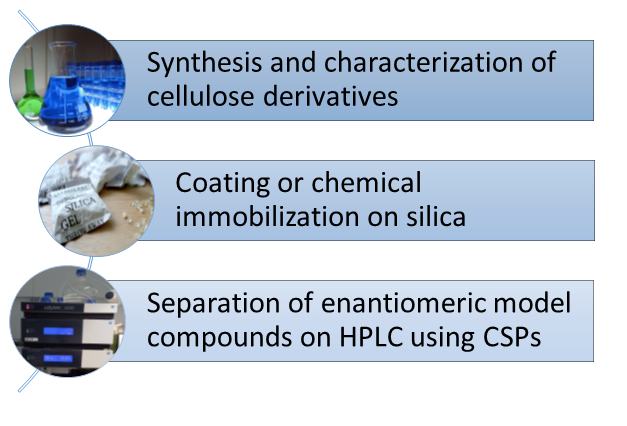Enantioseparation on non-conventional cellulose-based chiral phases
SUPERVISORS: Thomas ROSENAU, Hubert HETTEGGER
PROJECT ASSIGNED TO: Anna Florentina LEHRHOFER
Enantiomers are pairs of chiral molecules whose atoms are connected in the same way by chemical bonds but differ in their spatial arrangement. They are structured like mirror images of each other and their physical properties, except for their optical rotation, are identical. However, due to the remarkable selectivity or even specificity of enzymes, their biological behavior often notably differs, which is why frequently only one enantiomer of a certain molecule is bioactive and thus relevant in living organisms (e.g. L-amino acids, D-sugars). Due to their high similarity, the two enantiomers can only be separated from one another with highly advanced chromatographic techniques like high-performance liquid chromatography (HPLC) or gas chromatography (GC), if the separating materials (chiral stationary phases, CSPs) themselves are chiral. Besides using specific synthetic materials, the implementation of natural chiral molecules as stationary phases is a favorable approach for both the analytical as well as the preparative separation of enantiomers/racemic mixtures on HPLC. Since Hesse and Hagel have first used cellulose triacetate as CSPs in the 1970s, numerous polysaccharide derivatives have been reported as suitable chiral selectors in HPLC applications.
This project will inter alia exploit the inherent chirality of the biopolymer cellulose for the separation of enantiomers. For an enhanced enantioseparation, different cellulose-based derivatives will be synthesized and their performance as enantioselectors will be tested and evaluated using HPLC after physical coating or chemical immobilization onto silica as chromatographic support. The newly developed polysaccharide derivatives and CSPs will be comprehensively characterized using analytical techniques like ATR-FTIR, GPC, liquid- and solid-state NMR spectroscopy, elemental analysis, etc.

